
Mono and Stereo - September 2021
An Interview With Ken Fritz On Eliminating Vibration In High-End Audio Playback
Audiophile, Ken Fritz, talks about the critical nature of eliminating vibration in audio playback, and how technology solutions like Negative-Stiffness vibration isolation have enabled the exceptional performance of his latest, quite unique and much applauded, high-end home audio system.
By Jim McMahon
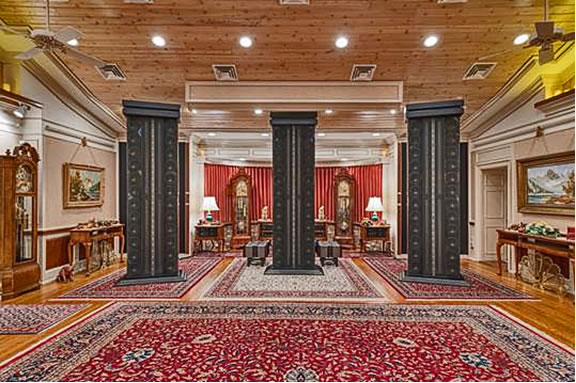
Ken Fritz' magnificent custom-built listening room.
"A good friend of mine, who did the machining of my custom turntable, asked me why I designed it to such an extreme extent to eliminate vibration. My answer was simple: Vibration will create noticeable disturbances in the sound reproduction. After building high-end audio systems with only the best equipment for over half a century, I designed this one to out-perform any of the others that I built. A critical part of this was eliminating vibration."
… Ken Fritz, 2021
Ken Fritz needs no introduction. Amongst serious audiophiles Ken is well known for his amazing ability with creating a legendary high-end audio playback system for his home. Reviews and comments about Ken's system can be found strewn throughout audio blogs, forums, websites and social media.
Recently, I had the opportunity to interview Ken regarding a very specific aspect of his audio set up: Vibration, and how he engineered his system to eliminate it. Following are excerpts from that interview.
Q: Ken, you expect an exceptionally high standard for the quality of your sound reproduction, when did you first start building audio systems to this criterion?
"In 1957 I went to a hi-fi show in Chicago, where I met a man named Saul Marantz, a father of high-end audio. I was very interested in a preamplifier, but being a sophomore in high school I didn't have much money coming from my paper route and doing odd jobs. A friend of my father, who had an appliance and auto parts warehouse, offered to buy the preamplifier for me if I would work for his company on Saturdays to work off the cost. This was really my first purchase of high-end audio equipment. From that point on I never did anything if I couldn't afford to buy the best. If I couldn't afford it, I just waited until I could, or I would build it."
"After high school I always knew people that needed help putting audio systems together and had the money to pay for high-end equipment. This gave me the wherewithal to build my own systems, as well, with the best components. As early as 1959 I was doing recordings of musical bands with my own Ampex professional tape machine and Neumann microphones, which were state-of-the-art at the time."
Q: Your latest audio system is a considerable accomplishment, judging by the feedback from so many of your audiophile peers. Much of the system was designed and built by you. Tell me a little about your background which enabled you to take on such a challenge.
"My experience early on with applied mathematics and physics from the University of Wisconsin/Milwaukee, and as a junior research engineer with factory automation electronics for Allen-Bradley, prepared me fairly well to understand the electrical and physical mechanics of audio systems. One thing no one does is design and build their own electronics. But it's not that hard. If you are intelligent, and go through the data sheets from the manufacturers, and look for equipment that will blend together, you can build something that is pretty good."
"Later on I set up my own tooling company that made patterns, masters and production fiberglass molds for manufacturing. All of this foundation contributed to the realization of my goals with building out exceptional high-performance audio playback systems, with all the gear that goes with it, culminating with this latest system which was 14 years in the making."
Q: I would like to focus on an aspect of audio playback systems that is frequently overlooked, and that is vibration isolation. How critical is the elimination of vibration in high-end audio playback?
"It is very crucial. Vibrations in the range of 2 hertz (Hz) to 20,000 Hz will influence the sound reproduction in audio systems. These vibrations can emanate from footsteps in the vicinity of the turntable, doors and windows closing, HVAC systems, speakers, external traffic, nearby construction, loud noise from aircraft, wind and other weather conditions."
"These internal and external influences primarily cause lower frequency vibrations which are transmitted through the structure and the air, and can be sensed by the turntable’s stylus and affect the sound playback from the LP. Depending on how far away the audio system is from these vibration sources will determine how strongly the sound quality will be influenced."
Q: Manufacturers of high-end turntables recognize that vibration is a problem, and do address it to some degree through turntable geometry, platter inertia, the quality of the bearings, and vibration damping. But are these approaches sufficient?
"No, they are not sufficient, that is, if one is interested in realizing the highest quality of sound reproduction. There are, however, a number of factors to consider that contribute to eliminating vibration that are beyond the immediate design of the turntable, tone arm and cartridge. But let me share some of my own perspective on designing turntables to eliminate vibration."
"My latest turntable, which I designed and built myself, weighs 750 pounds. At that weight it takes a considerable force to physically move it."
"It is fitted with a custom engineered Sota 80-pound lead vacuum platter, so when the LP is sucked down to the platter there is less vibration coming from the stylus as it makes the cut through the groove. I wanted a heavyweight platter so that floor and airborne vibrations would have more difficulty in exciting and transmitting to the phono cartridge. When I decided to design and build this table it was imperative that it incorporated a vacuum hold down. Why more high-end turntable designers haven’t adopted this feature is a mystery to me, as that is how master discs are held down to a heavy platter while being cut."
"A 5” high triangular-shaped plinth supports the 4” shaft of the platter. The interior of the plinth is internally back filled with 280 pounds of epoxy resin and #9 lead shot. This high amount of mass makes excitation by air or floor-borne vibrations difficult.”

The turntable's 3 drive pods, each with 2 synchronous motors, drive a15 lb. flywheel.
"Three drive pods, each comprised of two synchronous motors fitted with appropriate size pulleys, are connected by triple o-rings to a 15-pound stainless steel flywheel, which they drive. The flywheel is, in turn, connected to the perimeter of the platter and drives the platter via two larger o-rings. The base of each of the three pods is machined out and back filled with 60 pounds of exoxy/lead shot. This added ballast further reduces vibrations within the drive pods. Three of these motor/flywheel drive pods are used to power the platter, and are spaced 120 degrees from each other, thus, equalizing the radial force on the platter shaft. I chose a thrust ball bearing system for the platter that would carry a load of up to 150 lbs. This arrangement minimizes speed variation, and reduces vibration coming from the three motor drive pods."
"The turntable sits on a 1-1/4" thick, 30" x 30" aluminum plate, which rests on a Minus K Negative-Stiffness vibration isolator."
Q: Tell me about the Minus K Negative-Stiffness vibration isolator.
"With any audio system the speakers will generate vibration through the air, the floor and the walls. I built three 9'-6" loudspeakers for my system. Each speaker is composed of three separate banks of drivers, each covering a different area. Each of those banks is, in turn, driven by its own amplifier. Additional amplifiers are used to drive the subwoofers, and side and rear surround loudspeakers. A dozen amplifiers with a combined output of 70,000 watts drive the entire system. With an LP playing classical music, standing back 30 feet from my array, I can feel the music pounding on my chest. It was critical to further isolate the turntable from these intense vibrations emanating from my speakers."
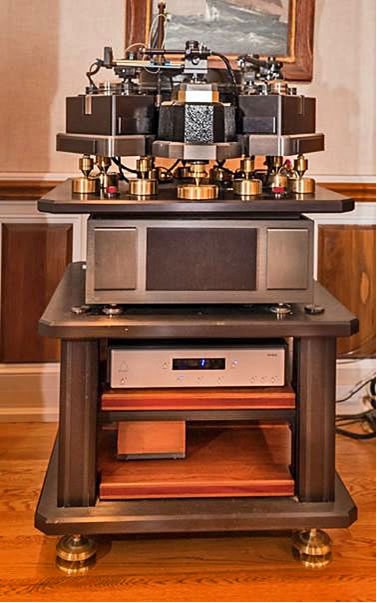
750 lb. turntable with Sota 80 lb. lead vacuum platter, atop a Minus K vibration isolator.
"These largely horizontal, low-frequency vibrations are not completely eliminated through conventional vibration isolation methods used with high-end turntables and their components. You can spend $100 grand for a turntable, $20,000 for a tone arm and $10,000 for a cartridge, and still have a vibration problem. You've got to deal with those horizontal vibrations coming from the speakers."
"Since the early 2000s, Minus K Technology, the developer of Negative-Stiffness vibration isolation, has released several vibration isolation platforms for the high-end audio market. These systems have been accepted with high acclaim by audiophiles and high-end audio manufacturers worldwide. Like everything else I did with my system, I researched their vibration isolators thoroughly. I spoke with the inventor and owner of Minus K, Dr. David Platus, discussed my needs, and they customized a vibration isolator that would accommodate my 750-pound turntable, and provide nearly 100 percent vibration isolation for both horizontal and vertical vibrations."
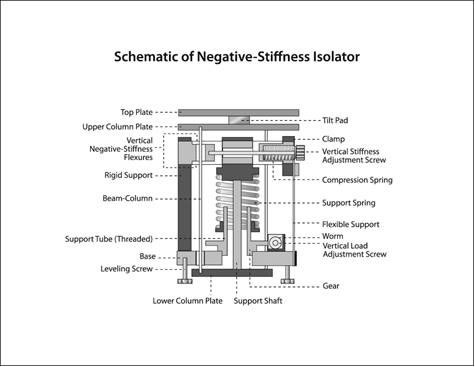
Schematic of a Minus K Negative-Stiffness Isolator
"Their platforms are known for isolating vibration down to 0.7 Hz vertical frequency and 0.5 Hz horizontal frequency, which has set the low-frequency standard not just in audio reproduction, but in ultra-sensitive scientific research."
"Another important factor for me is the Negative-Stiffness isolator operates as a totally passive device. No vacuum pumps, and none of the extra noise that goes with a pump or the complexity that it brings to an audio system. Also, they do not use electricity. If audio systems can be isolated from vibrations without having to deal with compressed air or electricity, then it makes for a system that is simpler to install, easier to set-up, and more reliable to operate and maintain."
"Essentially, the Minus K vibration isolator removes the extraneous noise, and allows the sound to be experienced with greater clarity. I was so impressed with the performance of this isolator that I had Minus K send me two more, one for each of my lighter backup turntables."
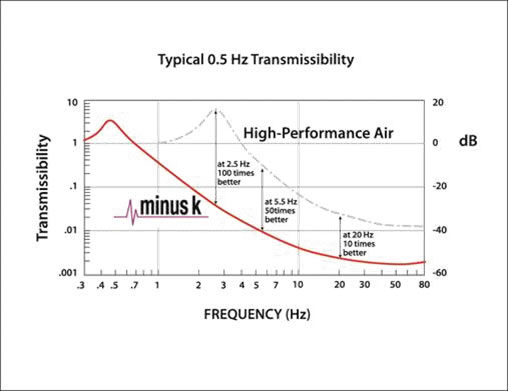
Transmissibility, Minus K Negative-Stiffness isolator versus air table.
Q: I understand you also designed your listening room to eliminate vibration.
"Yes. Supporting the turntable stand and speakers I have an 8" thick concrete slab that forms the foundation of my free-standing 30' x 55' listening room, which is separate from, but adjoins my home, built specifically for this purpose."
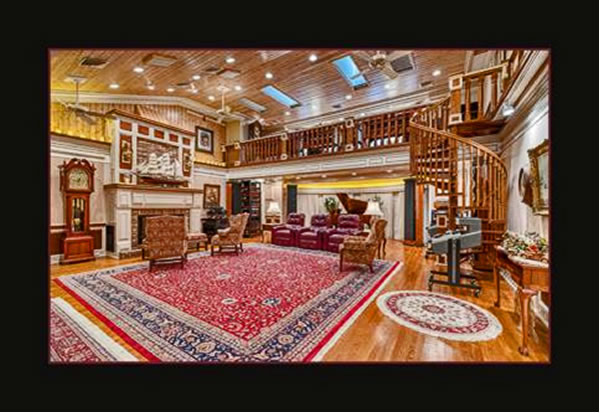
Floor to ceiling, designed for optimized sound reproduction.
"The walls are 12-inch cinder block that was laid with Durawall steel mesh between each course. Each vertical cavity was then filled with 1-inch rebar and then with 3,500 PSI pea gravel concrete. The walls were then built out with 2×6 studs on 12-inch centers, and purlins every 2 feet vertically. 4' x 8' x ¾-inch-thick plywood was glued and screwed to the studs and perlins. Then, two layers of 5/8" fire-code sheetrock was glued with Durabond 90 and screwed to the plywood. This construction technique was suggested to me by Jim Thiel of Thiel Audio. While he was constructing his listening room, I was beginning on mine, and his construction method seemed to be the cat’s meow, so I adopted it. In addition to Jim Thiel’s suggestion, I read The Master Handbook of Acoustics by F. Alton Everest. This is the go-to book for those looking to build a room such as mine. There was a good deal of other information included within the book that was nowhere else to be found. That definitely made a difference.”
"The walls support a 12' ceiling at the front and 17' ceiling at the rear. I approximated the ceiling design from a concert hall in Osaka, Japan."
"With this construction design, the walls and floor of the room reduce vibration from the sound coming from the speakers and from other external sources."
Q: Ken, do you have any final comments?
"One of the good things about the audio experience is that there is more than enough room for different approaches to a satisfying listening experience."
"The physics behind all products available to the audiophile can be demonstrated by the manufacturer. Their thoughts regarding why a speaker cone, electrons in an amplifier circuit, or the flexing of a cartridge’s cantilever can be scientifically explained while listening to their particular products."
"But the workings of one’s own ear will either confirm or not the resulting music as being smooth, harsh or something in between. I guess that is why there are so many top-line manufacturers in the audio business that offer different results obtainable for the same musical signal."
"With my system, whether I am playing LP or tape, I wanted each instrument on each channel to be controlled separately, so to have the capability to achieve a perfectly blended sound, and for that sound to be retrieved with as little modification and distortion as physically and electronically possible.”
About Minus K Technology, Inc.
Minus K® Technology, Inc. was founded in 1993 to develop, manufacture and market state-of-the-art vibration isolation products based on the company’s patented negative-stiffness technology. Minus K products are used in a broad spectrum of applications including microscopy, nanotechnology, biological sciences, semiconductors, materials research, zero-g simulation of spacecraft, and high-end audio. The company is an OEM supplier to leading manufacturers of scanning probe microscopes, micro-hardness testers and other vibration-sensitive instruments and equipment. Minus K customers include private companies and more than 300 leading universities and government laboratories in 52 countries.
Dr. David L. Platus is the inventor of negative-stiffness isolators, and President and Founder of Minus K Technology, Inc. (www.minusk.com). He earned a B.S. and a Ph.D. in Engineering from UCLA, and a diploma from the Oak Ridge School of (Nuclear) Reactor Technology. Prior to founding Minus K Technology he worked in the nuclear, aerospace and defense industries conducting and directing analysis and design projects in structural-mechanical systems. He became an independent consultant in 1988. Dr. Platus holds over 20 patents related to shock and vibration isolation.
For more information on Negative-Stiffness isolators please contact Steve Varma, Minus K Technology, Inc.; 460 Hindry Ave., Unit C, Inglewood, CA 90301; Phone 310-348-9656; Fax 310-348-9638; email sales@minusk.com; www.minusk.com.
************************
Jim McMahon writes on advances in technology. His features have appeared in more than 2,500 publications worldwide.
|